Information injection-pump assembly
ZEXEL
101401-4911
1014014911
ISUZU
8971001050
8971001050
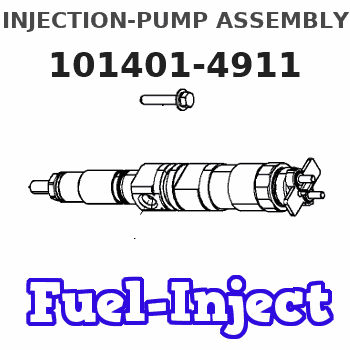
Rating:
Cross reference number
ZEXEL
101401-4911
1014014911
ISUZU
8971001050
8971001050
Zexel num
Bosch num
Firm num
Name
101401-4911
8971001050 ISUZU
INJECTION-PUMP ASSEMBLY
4HF1 * K
4HF1 * K
Calibration Data:
Adjustment conditions
Test oil
1404 Test oil ISO4113 or {SAEJ967d}
1404 Test oil ISO4113 or {SAEJ967d}
Test oil temperature
degC
40
40
45
Nozzle and nozzle holder
105780-8140
Bosch type code
EF8511/9A
Nozzle
105780-0000
Bosch type code
DN12SD12T
Nozzle holder
105780-2080
Bosch type code
EF8511/9
Opening pressure
MPa
17.2
Opening pressure
kgf/cm2
175
Injection pipe
Outer diameter - inner diameter - length (mm) mm 6-2-600
Outer diameter - inner diameter - length (mm) mm 6-2-600
Overflow valve
131424-4920
Overflow valve opening pressure
kPa
127
107
147
Overflow valve opening pressure
kgf/cm2
1.3
1.1
1.5
Tester oil delivery pressure
kPa
157
157
157
Tester oil delivery pressure
kgf/cm2
1.6
1.6
1.6
Direction of rotation (viewed from drive side)
Left L
Left L
Injection timing adjustment
Direction of rotation (viewed from drive side)
Left L
Left L
Injection order
1-3-4-2
Pre-stroke
mm
4.1
4.05
4.15
Rack position
Point A R=A
Point A R=A
Beginning of injection position
Governor side NO.1
Governor side NO.1
Difference between angles 1
Cal 1-3 deg. 90 89.5 90.5
Cal 1-3 deg. 90 89.5 90.5
Difference between angles 2
Cal 1-4 deg. 180 179.5 180.5
Cal 1-4 deg. 180 179.5 180.5
Difference between angles 3
Cyl.1-2 deg. 270 269.5 270.5
Cyl.1-2 deg. 270 269.5 270.5
Injection quantity adjustment
Adjusting point
-
Rack position
12.5
Pump speed
r/min
900
900
900
Average injection quantity
mm3/st.
67.5
65.9
69.1
Max. variation between cylinders
%
0
-4
4
Basic
*
Fixing the rack
*
Standard for adjustment of the maximum variation between cylinders
*
Injection quantity adjustment_02
Adjusting point
H
Rack position
9.8+-0.5
Pump speed
r/min
285
285
285
Average injection quantity
mm3/st.
15.5
14.2
16.8
Max. variation between cylinders
%
0
-10
10
Fixing the rack
*
Standard for adjustment of the maximum variation between cylinders
*
Injection quantity adjustment_03
Adjusting point
A
Rack position
R1(12.5)
Pump speed
r/min
900
900
900
Average injection quantity
mm3/st.
67.5
66.5
68.5
Basic
*
Fixing the lever
*
Injection quantity adjustment_04
Adjusting point
B
Rack position
R1+0.25
Pump speed
r/min
1600
1600
1600
Average injection quantity
mm3/st.
83.5
79.5
87.5
Fixing the lever
*
Injection quantity adjustment_05
Adjusting point
C
Rack position
R1-0.4
Pump speed
r/min
500
500
500
Average injection quantity
mm3/st.
47.8
43.8
51.8
Fixing the lever
*
Injection quantity adjustment_06
Adjusting point
E
Rack position
R1+0.15
Pump speed
r/min
1280
1280
1280
Average injection quantity
mm3/st.
78.5
74.5
82.5
Fixing the lever
*
Timer adjustment
Pump speed
r/min
1050--
Advance angle
deg.
0
0
0
Remarks
Start
Start
Timer adjustment_02
Pump speed
r/min
1000
Advance angle
deg.
0.5
Timer adjustment_03
Pump speed
r/min
1600
Advance angle
deg.
5
4.5
5.5
Remarks
Finish
Finish
Test data Ex:
Governor adjustment
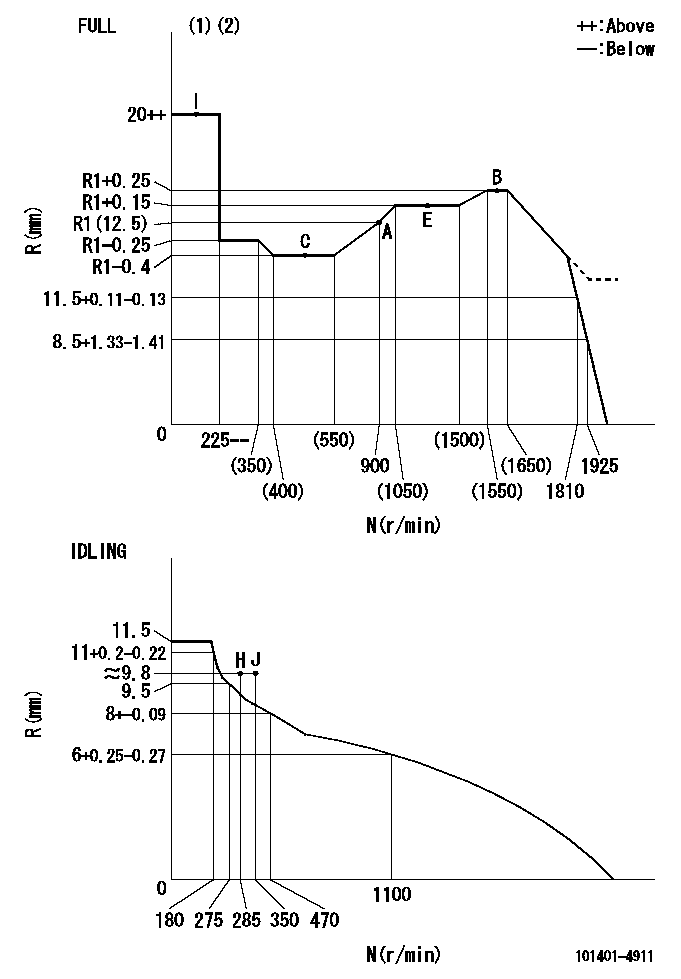
N:Pump speed
R:Rack position (mm)
(1)Torque cam stamping: T1
(2)Tolerance for racks not indicated: +-0.05mm.
----------
T1=J76
----------
----------
T1=J76
----------
Speed control lever angle
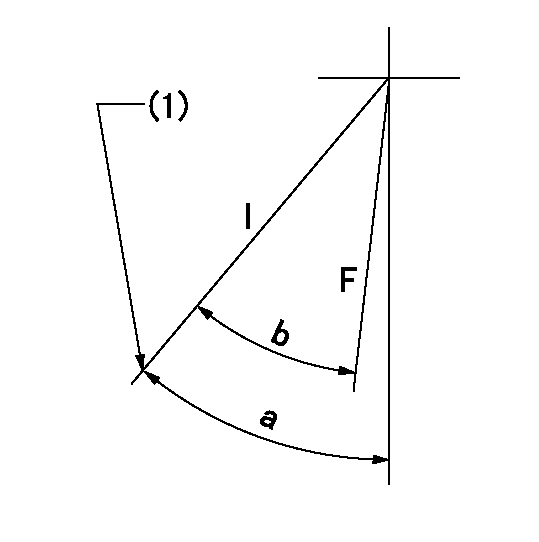
F:Full speed
I:Idle
(1)Stopper bolt set position 'H'
----------
----------
a=41deg+-5deg b=35deg+-3deg
----------
----------
a=41deg+-5deg b=35deg+-3deg
Stop lever angle
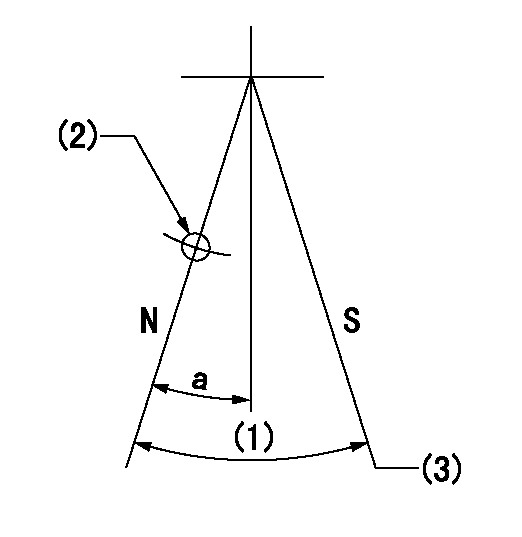
N:Pump normal
S:Stop the pump.
(1)(Actual measurement)
(2)Use the hole at R = aa
(3)At pump speed bb and rack position cc, set the stopper bolt.
----------
aa=25mm bb=1600r/min cc=5.5-0.5mm
----------
a=15deg+-5deg
----------
aa=25mm bb=1600r/min cc=5.5-0.5mm
----------
a=15deg+-5deg
0000001501 FICD
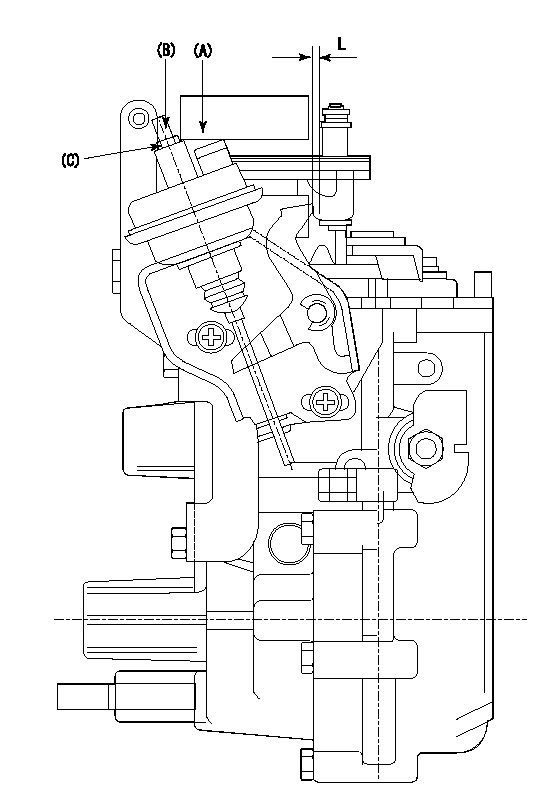
(A) applied negative pressure
(B) Screw
(c) Nut
1. Set the actuator as described below.
(1)Confirm that there is clearance between the actuator lever and the speed lever.
(2)Loosen the nut (C).
(3)Push in the screw (B).
(4)Apply P1 from the actuator (A) part.
(5)Pull out the screw (B) slowly.
(6)Tighten and fix the nut (C) when pump speed is Na and the rack position is Ra.
(7)Torque the nut (C) to T1.
(8)Apply P2 several times.
(9)Confirm that the actuator functions normally.
(10)Confirm that there is a clearance between the actuator lever and the speed lever at that time.
----------
P1=53.3kPa(400mmHg) P2=53.3kPa(400mmHg) Na=440r/min Ra=9.2+-0.1mm T1=1.2~1.6N-m(0.12~0.16kgf-m)
----------
L=(5)mm
----------
P1=53.3kPa(400mmHg) P2=53.3kPa(400mmHg) Na=440r/min Ra=9.2+-0.1mm T1=1.2~1.6N-m(0.12~0.16kgf-m)
----------
L=(5)mm
0000001601 RACK SENSOR
Rack sensor adjustment
(1)These types of rack sensors do not need adjustment. Confirm the output as described below.
(2)Mount the rack sensor main body to the pump main body.
(3)Measure the Vist at pump speed N1 and rack position Ra.
----------
N1=1600r/min Ra=R1(12.5)+0.25mm
----------
----------
N1=1600r/min Ra=R1(12.5)+0.25mm
----------
Timing setting
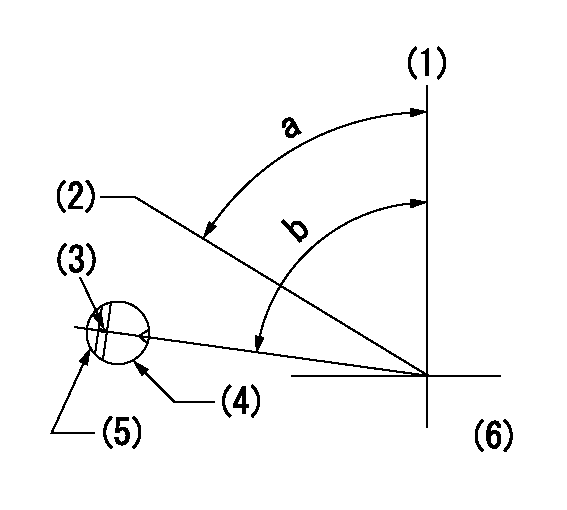
(1)Pump vertical direction
(2)Position of gear's standard threaded hole at No 1 cylinder's beginning of injection
(3)Timing device stamping
(4)Pump bracket check hole position.
(5)At the No 1 cylinder's beginning of injection, align with the projection seen through the bracket's check hole and mark the A/T's bevel C1.
(6)B.T.D.C.: aa
----------
aa=7deg
----------
a=(60deg) b=(85deg)
----------
aa=7deg
----------
a=(60deg) b=(85deg)
Information:
Display
The upper display (1) and lower display (2) of the GSC provide information about the generator set.* The upper display (1) shows AC voltage, current, and frequency of one phase of the generator output. Each phase can be viewed one at a time by pushing phase select key (4). The upper display (1) is also used to show the various fault codes for system faults. For more information on fault codes, refer to the Service Manual Module SENR5809 for Fault Descriptions.* The lower display (2) shows: system battery voltage, engine hours, engine speed, engine oil pressure, and engine coolant temperature. The value for one of those conditions is displayed for two seconds, then the display scrolls to the value for the next condition. A small pointer identifies the engine condition that corresponds to the value that is showing. When engine meter key (3) is pressed, the lower display stops scrolling and continuously shows one particular value. The pointer flashes above the condition whose value is showing. When the engine meter key is pressed a second time, the display returns to scrolling.* The lower display also shows a relay status indicator. When a GSC relay is activated, the corresponding relay indicator (K1, K2, etc.) is shown on lower display (2). When a relay is not activated, the corresponding indicator (K1, K2, etc.) is not shown. Refer to the Service Manual Module SENR5809 for a description of the relay functions.Both the upper and lower display are used for programming functions when in the service mode. For more information, refer to the Service Manual Module SENR5809 for Service Modes.Keypad
The keypad (3) is used to control the information that is shown on upper display (1) and the lower display (2). The seven keys of keypad have two sets of functions: normal functions and service functions. For a description of the service functions of the keys, refer to the Service Manual Module SENR5809 for Service Models. The normal functions of the keys are as follows. Leftmost key (5) - This key only functions when the GSC is in the service mode. This key is used to scroll right. PHASE SELECT key (6) - This key selects which phase of the generator output shows on the GSC upper display. Pressing this key allows the operator to check the voltage, current, and frequency of each phase, one at a time. ENGINE METER key (7) - This key stops the scrolling of engine conditions on the lower display (2). The lower display continuously shows the value for one particular engine condition. The pointer for the particular engine condition flashes to indicate scrolling is stopped. Pressing the key again resumes the scrolling. LAMP TEST key (8) - This key perfumes a lamp test on the GSC and the optional alarm module for a maximum of ten seconds, if held pressed. On the GSC: the eight fault indicators are ON CONTINUOUSLY - every segment of the upper display (1) and the lower display (2) are ON. For the
The upper display (1) and lower display (2) of the GSC provide information about the generator set.* The upper display (1) shows AC voltage, current, and frequency of one phase of the generator output. Each phase can be viewed one at a time by pushing phase select key (4). The upper display (1) is also used to show the various fault codes for system faults. For more information on fault codes, refer to the Service Manual Module SENR5809 for Fault Descriptions.* The lower display (2) shows: system battery voltage, engine hours, engine speed, engine oil pressure, and engine coolant temperature. The value for one of those conditions is displayed for two seconds, then the display scrolls to the value for the next condition. A small pointer identifies the engine condition that corresponds to the value that is showing. When engine meter key (3) is pressed, the lower display stops scrolling and continuously shows one particular value. The pointer flashes above the condition whose value is showing. When the engine meter key is pressed a second time, the display returns to scrolling.* The lower display also shows a relay status indicator. When a GSC relay is activated, the corresponding relay indicator (K1, K2, etc.) is shown on lower display (2). When a relay is not activated, the corresponding indicator (K1, K2, etc.) is not shown. Refer to the Service Manual Module SENR5809 for a description of the relay functions.Both the upper and lower display are used for programming functions when in the service mode. For more information, refer to the Service Manual Module SENR5809 for Service Modes.Keypad
The keypad (3) is used to control the information that is shown on upper display (1) and the lower display (2). The seven keys of keypad have two sets of functions: normal functions and service functions. For a description of the service functions of the keys, refer to the Service Manual Module SENR5809 for Service Models. The normal functions of the keys are as follows. Leftmost key (5) - This key only functions when the GSC is in the service mode. This key is used to scroll right. PHASE SELECT key (6) - This key selects which phase of the generator output shows on the GSC upper display. Pressing this key allows the operator to check the voltage, current, and frequency of each phase, one at a time. ENGINE METER key (7) - This key stops the scrolling of engine conditions on the lower display (2). The lower display continuously shows the value for one particular engine condition. The pointer for the particular engine condition flashes to indicate scrolling is stopped. Pressing the key again resumes the scrolling. LAMP TEST key (8) - This key perfumes a lamp test on the GSC and the optional alarm module for a maximum of ten seconds, if held pressed. On the GSC: the eight fault indicators are ON CONTINUOUSLY - every segment of the upper display (1) and the lower display (2) are ON. For the
Have questions with 101401-4911?
Group cross 101401-4911 ZEXEL
Isuzu
Isuzu
101401-4911
8971001050
INJECTION-PUMP ASSEMBLY
4HF1
4HF1